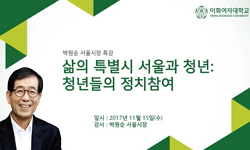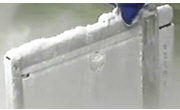대기오염은 인체에 각종 호흡기 질환을 일으킬 뿐 아니라 여러가지 다양한 문제를 야기하는데 서울시 대기오염의 상태는 어느정도이며 과연 우리에게 어떠한 영향을 얼마만큼이나 주고 있...
http://chineseinput.net/에서 pinyin(병음)방식으로 중국어를 변환할 수 있습니다.
변환된 중국어를 복사하여 사용하시면 됩니다.
- 中文 을 입력하시려면 zhongwen을 입력하시고 space를누르시면됩니다.
- 北京 을 입력하시려면 beijing을 입력하시고 space를 누르시면 됩니다.
https://www.riss.kr/link?id=T3213152
- 저자
-
발행사항
서울: 단국대학교, 1993
-
학위논문사항
학위논문(석사) -- 단국대학교 행정대학원 , 사회복지학과 사회복지전공 , 1993
-
발행연도
1993
-
작성언어
한국어
- 주제어
-
KDC
338
-
발행국(도시)
서울
-
형태사항
103p.: 삽도; 26cm
- 소장기관
-
0
상세조회 -
0
다운로드
부가정보
국문 초록 (Abstract)
본 연구는 서울시 지역에 한하여서 대기오염에 대하여 1991년도를 중심으로 환경처에서 지속적으로 측정한 자료가 있는 NO(2), HC, CO, TSP, SO(2), 산성비의 6개 향목에 대해 오염실태를 분석하고 그와같은 대기오염이 인간의 건강, 식물, 기후요소, 사회경제적 요소에 어떤 영향을 미쳤는지를 연구논문과 환경연감, 기상월보 등의 자료를 통해 고찰하였다.
본 연구의 결과를 요약하면 다음과 같다.
첫째, 대기오염의 실태를 분석한 결과 대기를 혼탁하게 하는 오염물질 배출은 선오염원과 면오염원이 대부분으로, 선오염왼은 전체 배출량의 NO(2) 76%, HC 65, 9%, CO 59%, TSP 35%, SO(2) 14%였고 면오염원은 NO(2) 11.9%, HC 33.8%, CO 40.8%, TSP 60.5%, SO(2) 68%였는데 선오염원의 원인은 자동차 수의 기하급수적인 증가로 절대 배출량이 커질 수 밖에 없었고 또한 오염물질 배출은 평균 차속의 감소에 따라 그 양이 현저히 증가하는데, 도로가 부족하여짐에 따라 평균 주행속도가 감소하게 되어 배출량이 더욱 증가하였다. 그리고 디젤 엔진의 버스나 트럭이 서울시에서의 차량구성 비율은 낮아도 대당 오염물질 배출량이 상당히 크기 때문인 것으로 나타났다. 그리고 면오염원의 원인은 과밀한 서울 인구로 인해 취사나 난방에서 나오는 배출량이 많기 때문이었다.
이와같은 오염물질 배출하에서 자동오염측정망에 계측된 서울시 대기오염도는 월변화를 보면 11월부터 2월까지의 겨울철에는 SO(2)와 TSP와 산성우의 오염도가 높았고 6월부터 8월까지의 여름철에는 O(3)의 오염도가 높았다. 특히 TSP는 지역적으로 편차가 커서 한남동, 성수동, 반포동, 쌍문동, 오류동의 지역에서 상당히 높은 수치였다.
연평균 기준치를 놓고 볼 때는 산성우만 기준치 이상이고 나머지 5개 항목은 기준치를 넘지 않는 양호한 오염도인 것으로 나다났는데 이는 대기가 깨끗해서라기 보다는 서울시에 설치된 20개 전지역의 지동오염 측정망의 위치가 한적한 곳의 옥상 등 비교적 공기가 나은 곳이어서 실제 서울시민이 생활하면서 받게되는 피폭량보다 낮은 수치로 측정되었기 때문인 것으로 판단된다.
둘째, 인간의 건강에 미친 영향으로 서울의 대기오염은 만성 호흡기계질환과 만성기관지염, 폐암사망율에 유의한 영향을 미치고 있었다.
셋째, 식물에 대해 서울의 산성비는 산림에서의 수목생장을 저해하여 낙엽률, 신초생장, 위축정도에 뚜렷한 차이를 나타내었고 대기중 SO(2)의 농도가 높으면 은행나무잎의 수용성 황함량도 높아져 광합성을 저해하는 등 식물에의 피해가 컸다.
넷째, 1943~1949년과 1986~1992년의 기온과 일조시간을 비교한 결과 40년대에 비해 일조시간은 약 17%나 감소하였으며 대기오염으로 공기가 혼탁해져서 태양광선이 차단되는 양산효과(Umbrellar effect) 때문에 여름철 기온은 감소 하였고 가스상 오염물질이 열방출을 막는 온실효과(greenhouse effect)때문에 겨울철 기온은 높아진 것으로 나타나 대기오염이 기후요소에도 영향을 미치고 있음을 알 수 있었다.
다섯째, 서울시 대기오염도는 사회경제적 요소에도 영향을 미쳐 사회경제적 수준이 낮다고 볼 수 있는 저소득층 지역이 사회경제적 수준이 높다고 볼 수 있는 고소득층 지역보다 대기오염이 심하였다.
이상과 같은 연구의 결과 서울시의 대기오염을 줄이고 대기질을 개선하기 위한 방안은 다음과 같다.
첫째, 대기질 평가의 근거가 되는 대기오염도가 정확히 측정될 수 있도록 지동오염측정망은 실제 생활 피폭량과 같은 측정치를 얻을 수 있는 장소에 많이 설치되어야 한다.
둘째, 선오염원으로 인한 대기오염 대책으로는 무공해 자동차를 생산 보급하고 무연 휘발유를 사용토록 하는 것이 가장 효과적이며 차선책으로써 자동차 수의 증가를 억제하고 디젤 엔진 차량의 오염물질 과다 배출에 대한 감독을 강화해야 하며 아울러 평균 주행 속도가 증가되도록 도시 종합교통규제, 도로구조의 개선, 물자운송시스템의 합리화 등 각종 시책을 종합적으로 유효적절히 강구해야 한다.
셋째, 면오염원에 대한 대책으로는 서울에의 인구집중을 막는 것이 가장 효과적이고 그 차선책으로는 난방을 위한 연료연소시 오염물질 배출이 적은 연료를 사용하도록 연구개발해야 한다.
마지막으로 기업체에서 가정에 이르는 법 국민에게 환경의 중요성을 인식시키는 환경교육을 실시하여 오염으로 인해 우리에게 초래되는 결과를 정확하게 알림으로 모든 사람이 깨끗한 공기를 유지해야 겠다는 가치관을 갖고 각자의 위치에서 노력하게 해야 하며 특히 정부는 각종 환경분야에 관련된 조사연구나 기술개발업무에 대해 어느 분야보다 우선순위를 두고서 예산지원을 확충하고 적극적으로 추진시켜야 할 것이다.
대기오염은 인체에 각종 호흡기 질환을 일으킬 뿐 아니라 여러가지 다양한 문제를 야기하는데 서울시 대기오염의 상태는 어느정도이며 과연 우리에게 어떠한 영향을 얼마만큼이나 주고 있는지 알아보고자 하였다.
본 연구는 서울시 지역에 한하여서 대기오염에 대하여 1991년도를 중심으로 환경처에서 지속적으로 측정한 자료가 있는 NO(2), HC, CO, TSP, SO(2), 산성비의 6개 향목에 대해 오염실태를 분석하고 그와같은 대기오염이 인간의 건강, 식물, 기후요소, 사회경제적 요소에 어떤 영향을 미쳤는지를 연구논문과 환경연감, 기상월보 등의 자료를 통해 고찰하였다.
본 연구의 결과를 요약하면 다음과 같다.
첫째, 대기오염의 실태를 분석한 결과 대기를 혼탁하게 하는 오염물질 배출은 선오염원과 면오염원이 대부분으로, 선오염왼은 전체 배출량의 NO(2) 76%, HC 65, 9%, CO 59%, TSP 35%, SO(2) 14%였고 면오염원은 NO(2) 11.9%, HC 33.8%, CO 40.8%, TSP 60.5%, SO(2) 68%였는데 선오염원의 원인은 자동차 수의 기하급수적인 증가로 절대 배출량이 커질 수 밖에 없었고 또한 오염물질 배출은 평균 차속의 감소에 따라 그 양이 현저히 증가하는데, 도로가 부족하여짐에 따라 평균 주행속도가 감소하게 되어 배출량이 더욱 증가하였다. 그리고 디젤 엔진의 버스나 트럭이 서울시에서의 차량구성 비율은 낮아도 대당 오염물질 배출량이 상당히 크기 때문인 것으로 나타났다. 그리고 면오염원의 원인은 과밀한 서울 인구로 인해 취사나 난방에서 나오는 배출량이 많기 때문이었다.
이와같은 오염물질 배출하에서 자동오염측정망에 계측된 서울시 대기오염도는 월변화를 보면 11월부터 2월까지의 겨울철에는 SO(2)와 TSP와 산성우의 오염도가 높았고 6월부터 8월까지의 여름철에는 O(3)의 오염도가 높았다. 특히 TSP는 지역적으로 편차가 커서 한남동, 성수동, 반포동, 쌍문동, 오류동의 지역에서 상당히 높은 수치였다.
연평균 기준치를 놓고 볼 때는 산성우만 기준치 이상이고 나머지 5개 항목은 기준치를 넘지 않는 양호한 오염도인 것으로 나다났는데 이는 대기가 깨끗해서라기 보다는 서울시에 설치된 20개 전지역의 지동오염 측정망의 위치가 한적한 곳의 옥상 등 비교적 공기가 나은 곳이어서 실제 서울시민이 생활하면서 받게되는 피폭량보다 낮은 수치로 측정되었기 때문인 것으로 판단된다.
둘째, 인간의 건강에 미친 영향으로 서울의 대기오염은 만성 호흡기계질환과 만성기관지염, 폐암사망율에 유의한 영향을 미치고 있었다.
셋째, 식물에 대해 서울의 산성비는 산림에서의 수목생장을 저해하여 낙엽률, 신초생장, 위축정도에 뚜렷한 차이를 나타내었고 대기중 SO(2)의 농도가 높으면 은행나무잎의 수용성 황함량도 높아져 광합성을 저해하는 등 식물에의 피해가 컸다.
넷째, 1943~1949년과 1986~1992년의 기온과 일조시간을 비교한 결과 40년대에 비해 일조시간은 약 17%나 감소하였으며 대기오염으로 공기가 혼탁해져서 태양광선이 차단되는 양산효과(Umbrellar effect) 때문에 여름철 기온은 감소 하였고 가스상 오염물질이 열방출을 막는 온실효과(greenhouse effect)때문에 겨울철 기온은 높아진 것으로 나타나 대기오염이 기후요소에도 영향을 미치고 있음을 알 수 있었다.
다섯째, 서울시 대기오염도는 사회경제적 요소에도 영향을 미쳐 사회경제적 수준이 낮다고 볼 수 있는 저소득층 지역이 사회경제적 수준이 높다고 볼 수 있는 고소득층 지역보다 대기오염이 심하였다.
이상과 같은 연구의 결과 서울시의 대기오염을 줄이고 대기질을 개선하기 위한 방안은 다음과 같다.
첫째, 대기질 평가의 근거가 되는 대기오염도가 정확히 측정될 수 있도록 지동오염측정망은 실제 생활 피폭량과 같은 측정치를 얻을 수 있는 장소에 많이 설치되어야 한다.
둘째, 선오염원으로 인한 대기오염 대책으로는 무공해 자동차를 생산 보급하고 무연 휘발유를 사용토록 하는 것이 가장 효과적이며 차선책으로써 자동차 수의 증가를 억제하고 디젤 엔진 차량의 오염물질 과다 배출에 대한 감독을 강화해야 하며 아울러 평균 주행 속도가 증가되도록 도시 종합교통규제, 도로구조의 개선, 물자운송시스템의 합리화 등 각종 시책을 종합적으로 유효적절히 강구해야 한다.
셋째, 면오염원에 대한 대책으로는 서울에의 인구집중을 막는 것이 가장 효과적이고 그 차선책으로는 난방을 위한 연료연소시 오염물질 배출이 적은 연료를 사용하도록 연구개발해야 한다.
마지막으로 기업체에서 가정에 이르는 법 국민에게 환경의 중요성을 인식시키는 환경교육을 실시하여 오염으로 인해 우리에게 초래되는 결과를 정확하게 알림으로 모든 사람이 깨끗한 공기를 유지해야 겠다는 가치관을 갖고 각자의 위치에서 노력하게 해야 하며 특히 정부는 각종 환경분야에 관련된 조사연구나 기술개발업무에 대해 어느 분야보다 우선순위를 두고서 예산지원을 확충하고 적극적으로 추진시켜야 할 것이다.
다국어 초록 (Multilingual Abstract)
The purpose of this study is to analyze the conditions of air pollution in Seoul by calculating the contents of six pollutants in air(NO(2), HC, CO, TSP, SO(2) and acid rain) which are available as of the year of 1991, and thereupon review the effects of air pollution on human health, plants, weather elements and socio-economic factors. To this end, preceding studies and publications such as "Environment Year-Book" and "Monthly Weather" were examined.
The result of study can be summarized as follows;
First, most of air pollutants originate from line and area sources 76% of NO(2), 65.9% of HC, 59% of CO, 35% of TSP and 14% of SO(2) stem from line sources, while 11.9% of NO(2), 33.8% of HC, 40.8% of CO, 60.5% of TSP and 68% of SO(2) are attributable to area sources. The line sources of pollution have extended in terms of their absolute capacity due to the geometric increase of automobiles. Moreover, the decreasing average drive speed due to the relative shortage of roads adds up to increasing air pollutants. In particular, diesel-engine buses and trucks are major culprits of air pollution despite the fact that they comprise a small proportion of total vehicles. On the other hand, the area sources of air pollution are caused by increasing cooking/heating due to concentrated population.
If we look at the monthly changes measured by the automatic pollution network, such elements as S0(2), TSP and acid rains are higher during winter from November to February, while 0(3) is higher during summer from June to August. In particular, the distribution of TSP is more deviated. That is, such areas as Han-nam-dong, Songsu-dong, Banpo-dong, Ssangmun-dong and Oryu-dong have more contents of TSP.
In view of annual average values, only the acid rains exceed the criterion, while the rest 5 elements remain under their limits, which may be attributable to the condition that the automatic pollution guage network installed at 20 points covers rather clean-air areas such as roof-tops than actual living environment, thus lowering the measurement than actual pollutant-bombardment.
Second, the air pollution is significantly co-related with the increase of such diseases as chronic respiratory diseases, chronic bronchitis and lung cancer.
Third, the acid rains have impeded the growth of plants affecting the rate of fallen leaves and growth of yound grass. Moreover, the increased concentration of SO(2) in air has also suppressed the assimilation of ginko trees by increasing the content of sulfur in their leaves.
Fourth, the duration of sunshine for 1986~1992 decreased by 17% compared with that for 1943~1949, while the summer-time temperature lowered due to the umbrella effects caused by polluted air. In contrast, the winter-time temperature rather rose due to the greenhouse effects caused by the gas pollutants which trap heat.
Fifth, the areas where lower-income people live are more polluted than those occupied by rich people, thus making the air pollution a socio-economic issue.
Based upon the above findings, the following reform measures are put forwards;
First, in order to precisely measure the air pollution, the automatic pollution guage should be installed at the places which have the same pollutant-bombardment as the living areas.
Second, in order to reduce the line sources of pollutants, such measures such as production of pollution-free automobiles, use of smokeless fuel, containment of automobiles, and increased supervision over diesel-engine vehicles, etc., should be taken. In addition, such measures such as improving the driving speed as comprehensive urban traffic controls, improvement of road structure and transportation system should be considered in a systematic way.
Third, in order to reduce the area sources of pollutants, the population of Seoul should first be de-centralized. As a next measure, such fuels as could decrease air pollution should be developed.
Finally, all the members of society including businesses and homes should be enlighted further to be well awakened of the importance of clean air. To this end, the government should more positively be involved in various environmental research projects and development ventures through expanded budgetary arrangements and administrative regulations.
Air pollution not only causes various respiratory diseases to the human body but also leads to diverse problems. Thus, there is a need to address the conditions of air pollution in Seoul and their impact on its residents. The purpose of this study i...
Air pollution not only causes various respiratory diseases to the human body but also leads to diverse problems. Thus, there is a need to address the conditions of air pollution in Seoul and their impact on its residents.
The purpose of this study is to analyze the conditions of air pollution in Seoul by calculating the contents of six pollutants in air(NO(2), HC, CO, TSP, SO(2) and acid rain) which are available as of the year of 1991, and thereupon review the effects of air pollution on human health, plants, weather elements and socio-economic factors. To this end, preceding studies and publications such as "Environment Year-Book" and "Monthly Weather" were examined.
The result of study can be summarized as follows;
First, most of air pollutants originate from line and area sources 76% of NO(2), 65.9% of HC, 59% of CO, 35% of TSP and 14% of SO(2) stem from line sources, while 11.9% of NO(2), 33.8% of HC, 40.8% of CO, 60.5% of TSP and 68% of SO(2) are attributable to area sources. The line sources of pollution have extended in terms of their absolute capacity due to the geometric increase of automobiles. Moreover, the decreasing average drive speed due to the relative shortage of roads adds up to increasing air pollutants. In particular, diesel-engine buses and trucks are major culprits of air pollution despite the fact that they comprise a small proportion of total vehicles. On the other hand, the area sources of air pollution are caused by increasing cooking/heating due to concentrated population.
If we look at the monthly changes measured by the automatic pollution network, such elements as S0(2), TSP and acid rains are higher during winter from November to February, while 0(3) is higher during summer from June to August. In particular, the distribution of TSP is more deviated. That is, such areas as Han-nam-dong, Songsu-dong, Banpo-dong, Ssangmun-dong and Oryu-dong have more contents of TSP.
In view of annual average values, only the acid rains exceed the criterion, while the rest 5 elements remain under their limits, which may be attributable to the condition that the automatic pollution guage network installed at 20 points covers rather clean-air areas such as roof-tops than actual living environment, thus lowering the measurement than actual pollutant-bombardment.
Second, the air pollution is significantly co-related with the increase of such diseases as chronic respiratory diseases, chronic bronchitis and lung cancer.
Third, the acid rains have impeded the growth of plants affecting the rate of fallen leaves and growth of yound grass. Moreover, the increased concentration of SO(2) in air has also suppressed the assimilation of ginko trees by increasing the content of sulfur in their leaves.
Fourth, the duration of sunshine for 1986~1992 decreased by 17% compared with that for 1943~1949, while the summer-time temperature lowered due to the umbrella effects caused by polluted air. In contrast, the winter-time temperature rather rose due to the greenhouse effects caused by the gas pollutants which trap heat.
Fifth, the areas where lower-income people live are more polluted than those occupied by rich people, thus making the air pollution a socio-economic issue.
Based upon the above findings, the following reform measures are put forwards;
First, in order to precisely measure the air pollution, the automatic pollution guage should be installed at the places which have the same pollutant-bombardment as the living areas.
Second, in order to reduce the line sources of pollutants, such measures such as production of pollution-free automobiles, use of smokeless fuel, containment of automobiles, and increased supervision over diesel-engine vehicles, etc., should be taken. In addition, such measures such as improving the driving speed as comprehensive urban traffic controls, improvement of road structure and transportation system should be considered in a systematic way.
Third, in order to reduce the area sources of pollutants, the population of Seoul should first be de-centralized. As a next measure, such fuels as could decrease air pollution should be developed.
Finally, all the members of society including businesses and homes should be enlighted further to be well awakened of the importance of clean air. To this end, the government should more positively be involved in various environmental research projects and development ventures through expanded budgetary arrangements and administrative regulations.
목차 (Table of Contents)
- 목차 = 0
- 제1장 서론 = 1
- 제1절 연구의 배경 및 목적 = 1
- 제2절 연구의 범위와 방법 = 3
- 제2장 대기오염에 관한 이론적 배경 = 5
- 목차 = 0
- 제1장 서론 = 1
- 제1절 연구의 배경 및 목적 = 1
- 제2절 연구의 범위와 방법 = 3
- 제2장 대기오염에 관한 이론적 배경 = 5
- 제1절 대기오염의 정의와 역사 = 5
- 1. 대기오염의 정의 = 5
- 2. 대기오염대책의 변천과정 = 9
- 3. 외국의 대기오염사건 = 11
- 제2절 대기환경기준과 측정 = 16
- 1. 대기오염물질의 종류 = 16
- 2. 대기오염원의 분류와 배출량 산정방법 = 26
- 3. 대기환경기준과 측정방법 = 29
- 제3절 대기오염의 영향 = 33
- 1. 인간에 미치는 영향 = 33
- 2. 식물에 미치는 영향 = 45
- 3. 기후요소에 미치는 영향 = 47
- 4. 사회경제적 요소에 미치는 영향 = 52
- 5. 기타 대기오염의 영향 = 54
- 제3장 서울시 대기오염의 실태와 그 영향 = 60
- 제1절 서울시 대기오염의 실태 = 60
- 1. 대기오염물질의 배출량 현황 = 60
- 2. 대기오염도 현황 = 66
- 제2절 서울시 대기오염의 영향 = 77
- 1. 인간에 미친 영향 = 77
- 2. 식물에 미친 영향 = 79
- 3. 기후요소에 미친 영향 = 80
- 4. 사회경제적 요소에 미친 영향 = 87
- 제3절 서울시 대기오염의 대책 = 88
- 제4장 결론 및 요약 = 91
- 참고문헌 = 95
- ABSTRACT = 100












